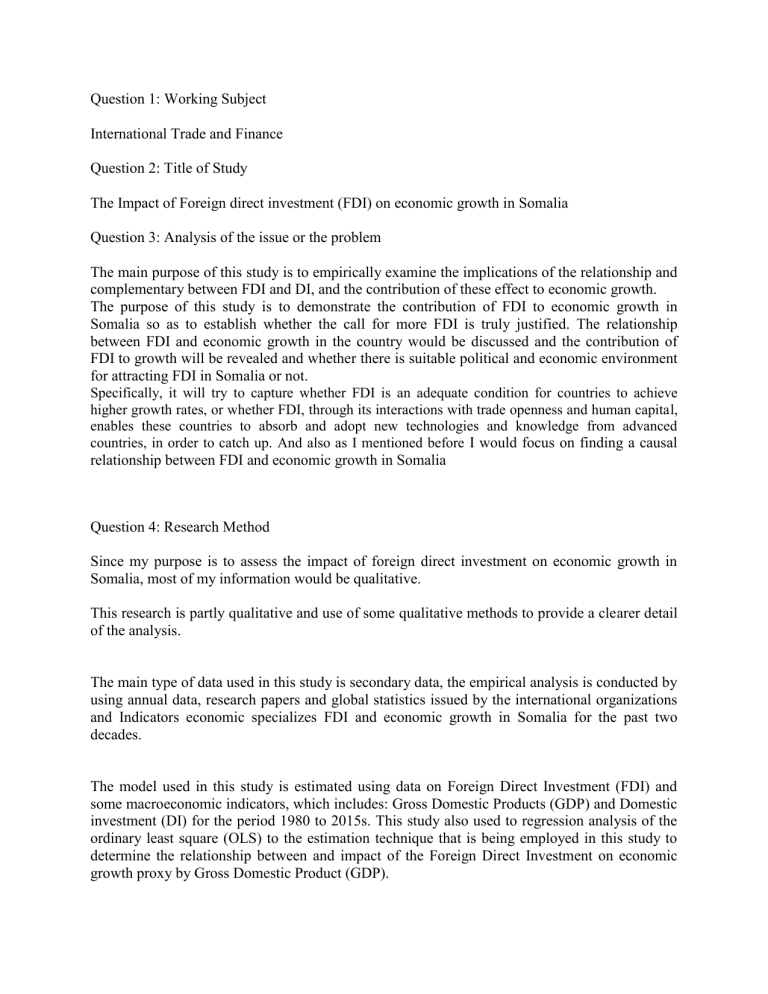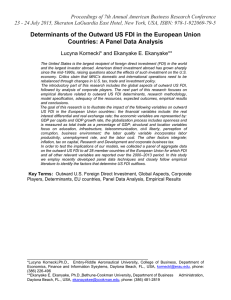
Question 1: Working Subject International Trade and Finance Question 2: Title of Study The Impact of Foreign direct investment (FDI) on economic growth in Somalia Question 3: Analysis of the issue or the problem The main purpose of this study is to empirically examine the implications of the relationship and complementary between FDI and DI, and the contribution of these effect to economic growth. The purpose of this study is to demonstrate the contribution of FDI to economic growth in Somalia so as to establish whether the call for more FDI is truly justified. The relationship between FDI and economic growth in the country would be discussed and the contribution of FDI to growth will be revealed and whether there is suitable political and economic environment for attracting FDI in Somalia or not. Specifically, it will try to capture whether FDI is an adequate condition for countries to achieve higher growth rates, or whether FDI, through its interactions with trade openness and human capital, enables these countries to absorb and adopt new technologies and knowledge from advanced countries, in order to catch up. And also as I mentioned before I would focus on finding a causal relationship between FDI and economic growth in Somalia Question 4: Research Method Since my purpose is to assess the impact of foreign direct investment on economic growth in Somalia, most of my information would be qualitative. This research is partly qualitative and use of some qualitative methods to provide a clearer detail of the analysis. The main type of data used in this study is secondary data, the empirical analysis is conducted by using annual data, research papers and global statistics issued by the international organizations and Indicators economic specializes FDI and economic growth in Somalia for the past two decades. The model used in this study is estimated using data on Foreign Direct Investment (FDI) and some macroeconomic indicators, which includes: Gross Domestic Products (GDP) and Domestic investment (DI) for the period 1980 to 2015s. This study also used to regression analysis of the ordinary least square (OLS) to the estimation technique that is being employed in this study to determine the relationship between and impact of the Foreign Direct Investment on economic growth proxy by Gross Domestic Product (GDP). As well as the descriptive methods are used to provide better understanding of relationship of foreign direct investments and economic growth in Somalia. For the same time descriptive would be used to examine the Determinants of Foreign Direct Investment in Somalia to know what determines to increase or decrease FDI whether it is political issue or environment and economic indicators itself. Question 5: General Structure of the study My study would have couple of heading and subheadings and divided into five chapters. The first chapter I would Introduction talking about importance of FDI investment on the economy and some short notes about FDI in Somalia for the past and now after that there are subheadings about research questions and so. Second Chapter would have reviews related literature about determinants of FDI and impact of FDI on economic growth. As well as I would demonstrate theoretical framework of FDI and its types how it is was talked about by scholars and identifying problems faced while they were trying to know the impact of FDI on economic growth and what they recommended . Third Chapter would be methodology which methods we are going to use whether qualitative or quantitative and anything related tools for using to analysis my data. Fourth Chapter would be Analysis and Findings as discussions about the results we would find. The Final chapter would be Conclusion and provides Recommendations. Question 6: Academic Contribution It is widely recognized that foreign direct investment affects economic growth in host economies both directly and indirectly. FDI contributes directly to employment, capital, exports, and new technology in the host country. In addition, local firms may benefit indirectly through improved productivity). This is why there is significant competition among governments to attract inward FDI using all kinds of incentives. For example, many governments, especially in developing economies, have adopted policies aimed at attracting foreign investors. This is based on the belief that the benefits from multinational corporations can affect productivity, enhance a country trade performance and upgrade the technological progress of the host country. Another example my country Somalia has one monopoly telecommunication firm which we call Hormuud so this firm is not facing tough competition other telecommunication firms are so weak what about if Vodafone open a new branch in Somalia, a competition should begin and people will benefit for getting cheaper services. The result of this study would be useful to foreign investors and development organizations seeking to better understand the role of FDI in Somalia. Question 7: Literature Review Foreign direct investment is recognized as a powerful engine for economic growth. It enables capital-poor countries to build up physical capital, create employment opportunities, develop productive capacity, enhance skills of local labor through transfer of technology and help integrate the domestic economy with the global economy. United Nations Conference on Trade and Development (2008) reports suggested that the global FDI flow grew strongly from the 1990s up to 2008 at rates well above those of global economic growth or trade. Also indicated that the total FDI reached $1.9 trillion in 2007, FDI flow starts its decline from 2008 (-16%). The decline was more pronounced in 2009 (-37%) due to the global economic crisis Admas (2009) analyze by his study on impact of foreign direct investment (FDI) and domestic investment (DI) on economic growth in Sub-Saharan Africa for the period 1990–2003 that DI positively and significantly correlated with Economic growth. His study also found that FDI initially has negative effect on DI and subsequently positive effect in the latter periods for the countries studied. The review of the literature and findings of the study indicate that the continent needs a targeted approach to FDI, increase absorption capacity of local firms, and cooperation between government and multinational enterprise (MNE) to promote their mutual benefit. (Mohamed & Isak, 2017) Studied that FDI is not strong and statistically important determinants of real GDP performance in Somalia, when compared with Domestic investment. The implication of this is that the policy linkage between real GDP and FDI are weak and unpredictable, It was recommended that future research should include other macroeconomic indicators (such as unemployment rate, gross national product, purchasing power parity, poverty level, and foreign exchange rate), which may help to better explain the effect of foreign investment on the economic growth of Somalia.





